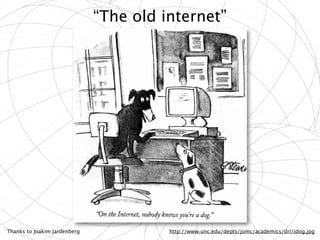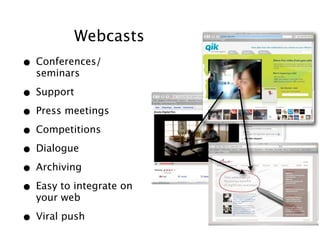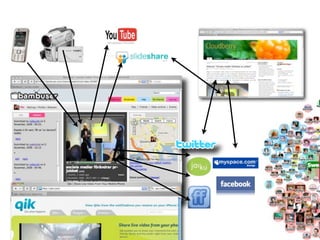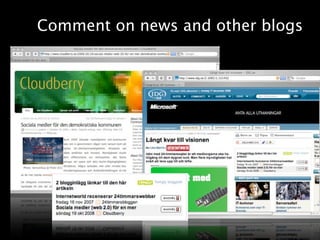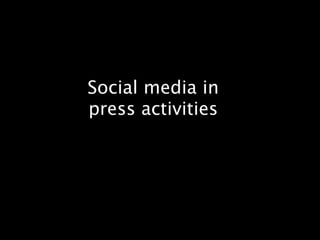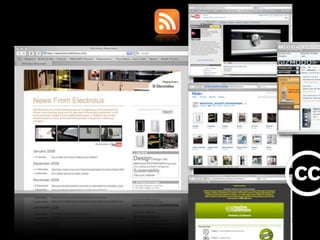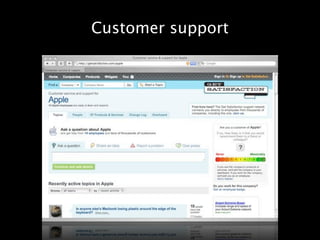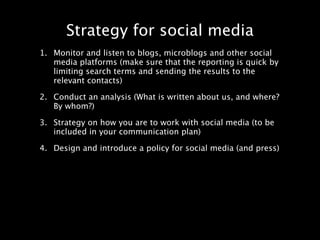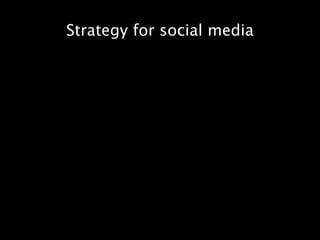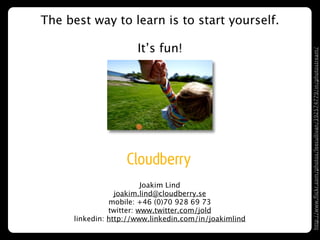Moving into Social Media
- 1. Moving into social media Communication Executives Programme http://www.flickr.com/photos/gustavog/9708628/ Joakim Lind, Ångström Lab, Uppsala 2009-05-08
- 2. A Sweden-based strategic PR and communications agency that helps companies and organisations reach Background out with their messages. » Established in 2000 » International profile » International network of partners Services » Offices in Stockholm and Malmö » Analysis and strategy » Traditional and social media Focus » Workshops and seminars » Corporate and consumer PR » Media training and coaching » Main focus: » Copy (blogs, cases, opinion, press) » ICT/Tech » Press material and media rooms » Clean tech » Crisis management » Environment » Place branding » Analysis www.cloudberry.se
- 4. Social media is information content created by people using highly accessible and scalable publishing technologies. At its most basic sense, social media is a shift in how people discover, read and share news, information and content. http://en.wikipedia.org/wiki/Social_media
- 6. Web 1.0 vs 2.0 - The Visual Difference http://www.sizlopedia.com/2007/08/18/web-10-vs-web-20-the-visual-difference/
- 7. Blogs Video/moving images Social networks/ platforms The Company Wikis Photos Microblogs Monitoring www.cloudberry.se
- 8. Is your website needed? http://www.modernista.com/7/index.php
- 9. What do you do? http://www.flickr.com/photos/briansolis/2735401175/
- 10. Background
- 11. The new media landscape • Newspaper sales decreasing • Radio and TV consumption going down • Internet usage increasing • Media consumption being individualised and differentiated http://mindpark.se/, IRM
- 12. Internet usage is increasing Traditional media – new channels http://mindpark.se/, World Internet Institute
- 13. YouTube up 72% in one year http://mindpark.se/, comScore Video Metrix
- 14. Open Source • Apache • Linux • MySQL • Firefox • World wide web
- 18. Death of the blog
- 19. “The old internet” Thanks to Joakim Jardenberg http://www.unc.edu/depts/jomc/academics/dri/idog.jpg
- 21. Dialogue Your ‘friends’ are your best capital Social media success is built on dialogue and generosity
- 22. Social media characteristics • Realness/authenticity • Generosity/reciprocity • Openness/transparency • Listening • Dialogue
- 23. Micro blogs
- 24. Bombay attacks
- 27. Different strategies, different tones
- 29. Friendfeed.com
- 33. Video
- 34. Virals
- 36. Technological innovations 36
- 39. Webcasts • Conferences/ seminars • Support • Press meetings • Competitions • Dialogue • Archiving • Easy to integrate on your web • Viral push
- 41. Listen
- 44. Media monitoring Blogs/development - Where are we being Traditional media forums mentioned, and how? - Who is writing about us? - The media image - Where do we want to initiate a dialogue? - How can we comment? - Should we comment? Companies/ organisations INPUT
- 45. Comment on news and other blogs
- 46. Social media in press activities
- 48. Customer support
- 49. Wikipedia How are you and your company described on Wikipedia?
- 50. Bookmarks
- 53. Creative Commons licence www.creativecommons.com • Be generous with material and the possibilities to use it • Can be used in press, blogs/websites and print
- 54. Follow up • Most things can be evaluated online • Ranking on search engines • What are the most read articles, and most commented stories • Most clicked images • Awareness related to inquiries/ sales • Brand analysis • Etc...
- 55. Strategy for social media
- 56. Strategy for social media 1. Monitor and listen to blogs, microblogs and other social media platforms (make sure that the reporting is quick by limiting search terms and sending the results to the relevant contacts)
- 57. Strategy for social media 1. Monitor and listen to blogs, microblogs and other social media platforms (make sure that the reporting is quick by limiting search terms and sending the results to the relevant contacts) 2. Conduct an analysis (What is written about us, and where? By whom?)
- 58. Strategy for social media 1. Monitor and listen to blogs, microblogs and other social media platforms (make sure that the reporting is quick by limiting search terms and sending the results to the relevant contacts) 2. Conduct an analysis (What is written about us, and where? By whom?) 3. Strategy on how you are to work with social media (to be included in your communication plan)
- 59. Strategy for social media 1. Monitor and listen to blogs, microblogs and other social media platforms (make sure that the reporting is quick by limiting search terms and sending the results to the relevant contacts) 2. Conduct an analysis (What is written about us, and where? By whom?) 3. Strategy on how you are to work with social media (to be included in your communication plan) 4. Design and introduce a policy for social media (and press)
- 60. Strategy for social media 1. Monitor and listen to blogs, microblogs and other social media platforms (make sure that the reporting is quick by limiting search terms and sending the results to the relevant contacts) 2. Conduct an analysis (What is written about us, and where? By whom?) 3. Strategy on how you are to work with social media (to be included in your communication plan) 4. Design and introduce a policy for social media (and press) 5. Division of responsibilities
- 61. Strategy for social media 1. Monitor and listen to blogs, microblogs and other social media platforms (make sure that the reporting is quick by limiting search terms and sending the results to the relevant contacts) 2. Conduct an analysis (What is written about us, and where? By whom?) 3. Strategy on how you are to work with social media (to be included in your communication plan) 4. Design and introduce a policy for social media (and press) 5. Division of responsibilities 6. Make sure that web pages can be indexed by search engines and web spiders
- 62. Strategy for social media 1. Monitor and listen to blogs, microblogs and other social media platforms (make sure that the reporting is quick by limiting search terms and sending the results to the relevant contacts) 2. Conduct an analysis (What is written about us, and where? By whom?) 3. Strategy on how you are to work with social media (to be included in your communication plan) 4. Design and introduce a policy for social media (and press) 5. Division of responsibilities 6. Make sure that web pages can be indexed by search engines and web spiders 7. Introduce a function to distribute material on your website (share/RSS)
- 63. Strategy for social media
- 64. Strategy for social media 8. Educate your organisation (social media success is to a large part built on individuals’ engagement and interest)
- 65. Strategy for social media 8. Educate your organisation (social media success is to a large part built on individuals’ engagement and interest) 9. Not everyone has to take part! (the need for engagement and authenticity)
- 66. Strategy for social media 8. Educate your organisation (social media success is to a large part built on individuals’ engagement and interest) 9. Not everyone has to take part! (the need for engagement and authenticity) 10. Be active in your dialogue. Reply to other people’s questions. Head, heart, gut.
- 67. Strategy for social media 8. Educate your organisation (social media success is to a large part built on individuals’ engagement and interest) 9. Not everyone has to take part! (the need for engagement and authenticity) 10. Be active in your dialogue. Reply to other people’s questions. Head, heart, gut. 11. Build personal networks on social web platforms
- 68. Strategy for social media 8. Educate your organisation (social media success is to a large part built on individuals’ engagement and interest) 9. Not everyone has to take part! (the need for engagement and authenticity) 10. Be active in your dialogue. Reply to other people’s questions. Head, heart, gut. 11. Build personal networks on social web platforms 12. Reciprocity
- 69. Strategy for social media 8. Educate your organisation (social media success is to a large part built on individuals’ engagement and interest) 9. Not everyone has to take part! (the need for engagement and authenticity) 10. Be active in your dialogue. Reply to other people’s questions. Head, heart, gut. 11. Build personal networks on social web platforms 12. Reciprocity 13. Start on a scale that you are able to handle and can manage
- 70. Strategy for social media 8. Educate your organisation (social media success is to a large part built on individuals’ engagement and interest) 9. Not everyone has to take part! (the need for engagement and authenticity) 10. Be active in your dialogue. Reply to other people’s questions. Head, heart, gut. 11. Build personal networks on social web platforms 12. Reciprocity 13. Start on a scale that you are able to handle and can manage 14. Integrate social media in everyday work routines
- 71. Strategy for social media 8. Educate your organisation (social media success is to a large part built on individuals’ engagement and interest) 9. Not everyone has to take part! (the need for engagement and authenticity) 10. Be active in your dialogue. Reply to other people’s questions. Head, heart, gut. 11. Build personal networks on social web platforms 12. Reciprocity 13. Start on a scale that you are able to handle and can manage 14. Integrate social media in everyday work routines 15. Evaluate regularly
- 72. The best way to learn is to start yourself. It’s fun! http://www.flickr.com/photos/leecullivan/392574779/in/photostream/ Joakim Lind joakim.lind@cloudberry.se mobile: +46 (0)70 928 69 73 twitter: www.twitter.com/jold linkedin: http://www.linkedin.com/in/joakimlind 57


















